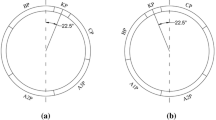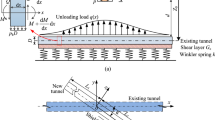Abstract
To explore the internal force and deformation response law of the Hangzhou subway shield pipe structure under engineering perturbations such as overhead loading, a self-developed “shield segment hydraulic loading system” was used to carry out a full-size loading test on a three-ring staggered segment. The influences of the lateral earth pressure coefficient, different loads under symmetric loading, and deviated load distance on the internal force and deformation of the shield tunnel segment are analyzed. Additionally, the transfer coefficient of the pipe sheet moment and the transverse stiffness were analyzed. The results show that the segment deformation and internal force decrease with the increasing lateral earth pressure coefficient. Under symmetric working conditions, the internal force and the deformation of the pipe sheets show different degrees of increase with a continuously increasing pile load above the tunnel. The internal force and deformation of the tubular sheets decrease gradually with increasing deflection distance, and the maximum convergence values of the tubular sheets are centered at 30° and 90°. The distribution of the number of mismatches in the results and the sensitivity to affecting factors differ significantly between the internal force and deformation. The bending stiffness increases with the increasing lateral soil pressure coefficient and pile load but decreases with increasing eccentric pile distance. The moment transfer coefficient has an approximately inverse relationship with the bending stiffness effective rate.




















Similar content being viewed by others
Data availability
The data that support the findings of this study are available from the corresponding author, upon reasonable request.
Abbreviations
- Symbol:
-
Definition (Unit)
- D 0 :
-
Tunnel outer diameter (m)
- H :
-
Tunnel vault burial depth (m)
- H w :
-
Underground water height (m)
- K :
-
Coefficient of soil resistance (-)
- M :
-
Bending moment (kNm)
- M f :
-
Bending moment at the longitudinal joints (kNm)
- M z :
-
Bending moment of the main section (kNm)
- p :
-
Surface load (kN)
- P g :
-
Vertical earth pressure generated at the bottom of the lining (kN)
- P 1 :
-
Vertical water and soil pressure at the top (kN)
- P 2 :
-
Vertical water and soil pressure at the bottom (kN)
- P p 1 :
-
Vertical force at the far end of the tunnel top caused by the heap load (kN)
- P p 2 :
-
Vertical force at the near end of the tunnel top caused by the heap load (kN)
- q p 1 :
-
Horizontal force at the bottom of the tunnel side caused by the heap load (kN)
- q p 2 :
-
Horizontal force at the top of the tunnel side caused by the heap load (kN)
- R e :
-
Radius of the lining centroid (m)
- s :
-
Horizontal distances between the loading center and the tunnel axis (m)
- λ:
-
Lateral earth pressure coefficient (-)
- γ :
-
Natural gravity (kN/m3)
- K j :
-
Bending stiffness of lining ring (kNm2)
- K s :
-
Bending stiffness of lining ring in modified routine method (kNm2)
- η :
-
Effective rate of bending stiffness (-)
- δ :
-
Horizontal displacement of the lining (mm)
- δ jmax :
-
Maximum convergence value of the lining structure without stiffness reduction (mm)
- δ smax :
-
Maximum convergence value of the lining structure with stiffness reduction (mm)
- ζ :
-
Moment transfer coefficient (-)
References
Sharma JS, Hefny AM, Zhao J (2001) Chan CW (2001) Effect of large excavation on deformation of adjacent MRT tunnels. Tunn Undergr Space Technol 16(2):93–98
Lo KY, Ramsay JA (1991) The effect of construction on existing subway tunnels——a case study from Toronto. Tunn Undergr Space Technol 6(3):287–297
Shao H, Huang HW, Zhang DM, Wang RL (2016) Case study on repair work for excessively deformed shield tunnel under accidental surface surcharge in soft clay. Chin J Geotech Eng 38(6):1036–1043
Huang HW, Zhang DM (2016) Resilience analysis of shield tunnel lining under extreme surcharge: characterization and field application. Tunn Undergr Space Technol 51(6):301–312
Zhang L, Feng K, Gou C, He C, Liang K, Zhang HH (2019) Failure tests and bearing performance of prototype segmental linings of shield tunnel under high water pressure. Tunn Undergr Space Technol 92:103053
Ma C, Xie WB, Liu ZL, Li QY, Tan GS (2020) A new technology for smooth blasting without detonating cord for rock tunnel excavation. Appl Sci 10(19):6764
Zhang WJ, Qi JB, Zhang GL, Niu RJ, Zhang C, He LC, Lyu JR (2022) Full-scale experimental study on failure characteristics of the key segment in shield tunnel with super-large cross-section. Tunn Undergr Space Technol 129:104671
Liu X, Ye YH, Liu Z (2018) Mechanical behavior of Quasi-rectangular segmental tunnel linings: First results from full-scale ring tests. Tunn Undergr Space Technol 71:440–450
Zhu YT, Zhang ZX, Huang X, Zhu YF, Wang SF (2019) Exploring the progressive failure characteristics of a large special-shaped shield tunnel lining based on ‘standing’ prototype loading tests. Tunn Undergr Space Technol 93:103–107
Schreyer J, Winselman D (2000) Suitability tests for the lining for the 4th Elbe tunnel tube—results of large-scale tests. Tunnel 1:33–44
He C, Fen K, Yan QX (2014) Prototype test study on mechanical characteristics of segmental lining structure of underwater railway shield tunnel. Eng Sci 12(2):65–74
Liu X, Zhang YM, Bao YH, Song W (2017) Investigation of the structural effect induced by stagger joints in segmental tunnel linings: first results from full-scale ring tests. Tunn Undergr Space Technol 66:1–18
Zhang ZX, Zhu YT, Huang X, Zhu YF, Liu W (2019) ‘Standing’ full-scale loading tests on the mechanical behavior of a special-shape shield lining under shallowly-buried conditions. Tunn Undergr Space Technol 86:34–50
Li SC, Wang MB (2008) Elastic analysis of stress–displacement field for a lined circular tunnel at great depth due to ground loads and internal pressure. Tunn Undergr Space Technol 23(6):609–617
Kang C, Mei GX, Liang RZ, Wu WB, Ke ZB (2018) Analysis of the longitudinal deformation of existing shield tunnel induced by temporary surface surcharge. Rock and Soil Mechanics 39:4605–4616
Kentaro Y, Lyamin AV, Wilson DW, Sloan SW, Abbo AJ (2011) Stability of a circular tunnel in cohesive-frictional soil subjected to surcharge loading. Comput Geotech 38:504–514
Kentaro Y, Lyamin AV, Wilson DW, Sloan SW, Abbo AJ (2013) Stability of dual circular tunnels in cohesive-frictional soil subjected to surcharge loading. Comput Geotech 50:41–54
Wang RL, Zhang DM (2013) Mechanism of transverse deformation and assessment index for shield tunnels in soft clay under surface surcharge. Chin J Geotech Eng 35(6):1092–1101
Huang Z, Zhang H, Fu HL (2020) Deformation response induced by surcharge loading above shallow shield tunnels in soft soil. KSCE J Civ Eng 24(8):2533–2545
Wei G, Zhang SM, Xiang PF (2021) Model test study on the influence of ground surcharges on the deformation of shield tunnels. Symmetry 13(9):1565
Liu ZL, Ma CD, Wei XA, Xie WB (2021) Experimental study on mechanical properties and failure modes of pre-existing cracks in sandstone during uniaxial tension compression testing. Eng Fract Mech 255:107966
Liu ZL, Ma CD, Wei XA (2022) Experimental study on the mechanical characteristics of single-fissure sandstone under triaxial extension. Rock Mech Rock Eng 55:4441–4457
Wei G, Hong WQ, Wei XJ, Jiang JQ (2020) Deformation law and control limit of shield tunnel cross-section under eccentric surcharge load. J Central South Univ 51(3):750–757
Attewell PB, Woodman JP (1982) Predicting the dynamics of ground settlement and its derivatives caused by tunnelling in soil. Ground Eng 15(8):13–22
Liang RZ, Xia YD, Hong Y, Yu F (2016) Effects of above-crossing tunnelling on the existing shield tunnels. Tunn Undergr Space Technol 58:159–176
Japanese Society of Civil Engineers (1977) The design and construction of underground structures. Japanese Society of Civil Engineers, Tokyo
Koyama Y, Nishimura T (1998) Design of lining segment of shield tunnel using a beam-spring model. Quarterly Report of RTRI (Railway Technical Research Institute, Japan) 39(1):23–27
Huang HW, Xu L (2006) Study on transverse effective rigidity ratio of shield tunnels. Chin J Geotech Eng 28(1):11–18
Fen K, He C, Xia SL (2011) Prototype tests on effective bending rigidity ratios of segmental lining structure for shield tunnel with large cross-section. Chin J Geotech Eng 33(11):1750–1758
Koyama Y (2003) Present status and technology of shield tunneling method in Japan. Tunn Undergr Space Technol 18(2):145–159
Guan ZC, Deng T, Wang G, Jiang YJ (2015) Studies on the key parameters in segmental lining design. J Rock Mech Geotech Eng 7(6):674–683
Acknowledgements
This research was supported by The Basic Public Welfare Research Projects in Zhejiang Province(Grant number: LGF22E080012) ; The General Scientific Research Projects for Agriculture and Social Development in Hangzhou [Grant number 20201203B127]. In addition, we also thank Technology Innovation and Training Center at the Polytechnic Institute of Zhejiang University and YantaiXintiandi Test Technology Co. Ltd., China, for their support in this experiment.
Author information
Authors and Affiliations
Corresponding author
Ethics declarations
Conflict of Interest
The authors declare that they have no known competing financial interests or personal relationships that could have appeared to influence the work reported in this paper.
Rights and permissions
Springer Nature or its licensor (e.g. a society or other partner) holds exclusive rights to this article under a publishing agreement with the author(s) or other rightsholder(s); author self-archiving of the accepted manuscript version of this article is solely governed by the terms of such publishing agreement and applicable law.
About this article
Cite this article
Wei, G., Huang, S., Feng, F. et al. Full-Scale Experimental Study on the Effect of Ground Surcharge on the Stress and Deformation of Shield Tunnels. Int J Civ Eng 21, 1403–1422 (2023). https://doi.org/10.1007/s40999-023-00827-3
Received:
Revised:
Accepted:
Published:
Issue Date:
DOI: https://doi.org/10.1007/s40999-023-00827-3




